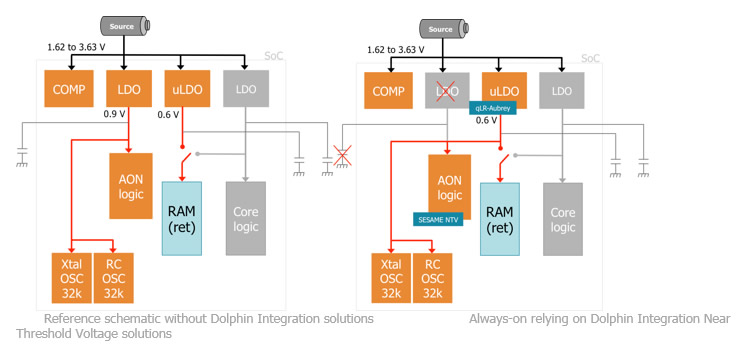Extend the operation time of your battery powered SoC
Allowing devices to run on the same battery for years rather than months significantly enhances end-user satisfaction. Numerous wireless communication SoC, whether BLE, Zigbee, Sigfox, LoRa or M2M 4G, have a duty cycle such that the power consumption in sleep mode dominates the overall current drawn from the battery.
For such applications, the design of the 'Always-On power domain' (AON power domain) is critical.
To extend the operation time of such battery-operated SoC by x2 to x5, Dolphin Integration proposes, from 40-180nm, three voltage regulators as part of its DELTA library.
Minimisation of the power consumption of an always-on domain indeed involves paying special attention to the construct of the power regulation network. The selection of the voltage regulator is critical, as it may contribute to more than 50% of the power consumption in sleep mode. Furthermore, the capability of an always-on power domain to operate at low voltage may significantly lower the power consumption while enabling silicon area and BoM cost savings.
The qLR-Aubrey is a linear regulator with a quiescent current as low as 150nA, including the reference/bandgap. This voltage regulator supports an input voltage as high as 5.5V (no special process option required) and an output voltage programmable down to 0.55V, i.e. the minimum data retention voltage of RAMs at 55nm uLP. Embedding a single instantiation of the qLR-Aubrey to supply both the blocks in data retention and the always-on domain allows saving silicon area and BoM cost while reducing by up to 80% the power consumption of a SoC in sleep mode.
To make such savings achievable, Dolphin Integration provides a complete set of silicon IPs optimised to operate Near Threshold Voltage: standard cell library (SESAME NTV), low power XTAL and RC oscillators.

Dealing with multiple voltage regulators to supply the same load in different power modes is challenging (risks of short circuits…). It combines two voltage regulators which operate alternatively: one during SoC active mode(s) – up to 1A – and the other during SoC sleep mode(s) – up to 1mA. The switching between the two voltage regulators is fully automatic – activated through a control signal – and is both fast and safe thanks to the Regulator Control Unit embedded in the RAR (Retention Alternating Regulator).
Depending on whether the target application of the SoC is more sensitive to BoM costs or to power consumption in active modes, SoC designers may select:
- The RAR-iLR-qLR combines a fast transient linear regulator (iLR-Victoria) with an ultra-low quiescent regulator (qLR-Aubrey) for the lowest BoM cost.
- The RAR-eSR-qLR combines a high-efficiency switching regulator (eSR-Niagara) with a low quiescent regulator (qLR-Aubrey) for the best power efficiency.
Provided with integration rules, guidelines and specific views, voltage regulators of the DELTA library may be easily and safely embedded, whatever the complexity of the power regulation network and the sensitivity of loads to noise (e.g. RF).
Dolphin Integration will unveil its complete offering of silicon IPs operating Near Threshold Voltage, and proven in the Taishan Demochip at TSMC 55nm uLP/uLP eF, during the TSMC symposiums in Santa-Clara (USA) on March 15th and in Shanghai (China) on March 28th.












